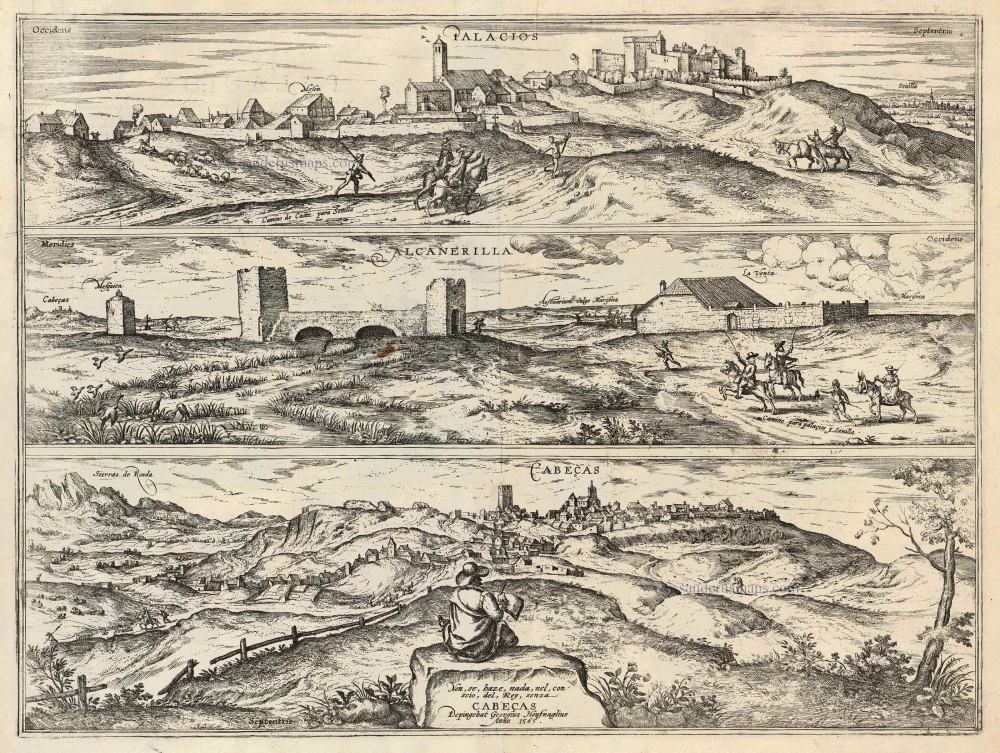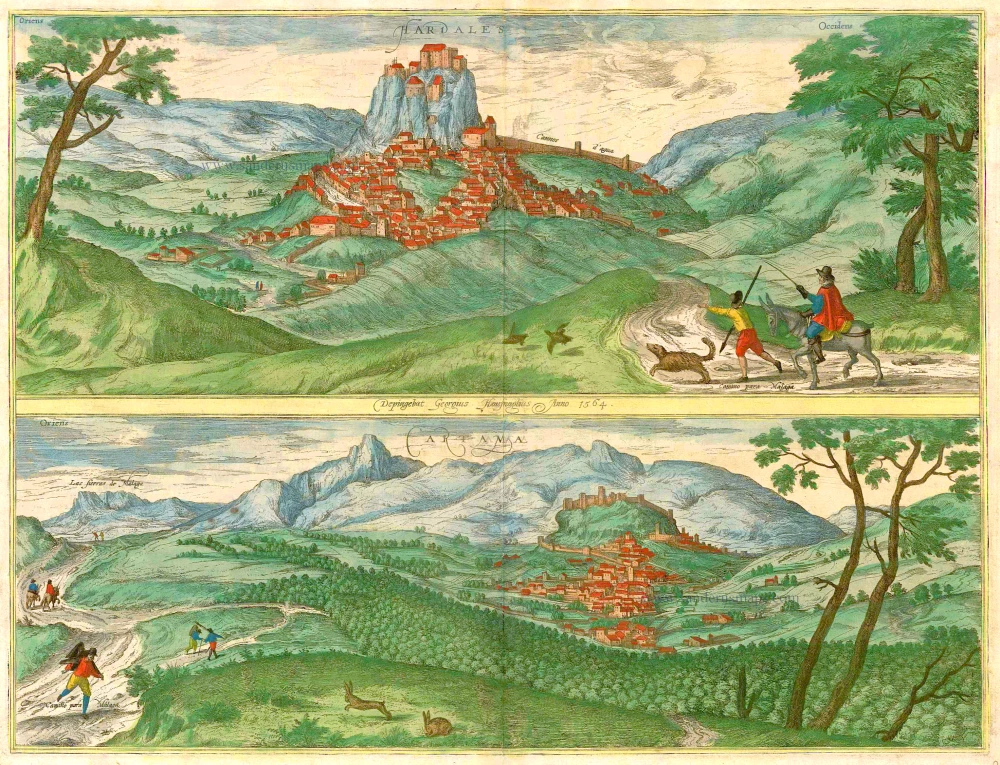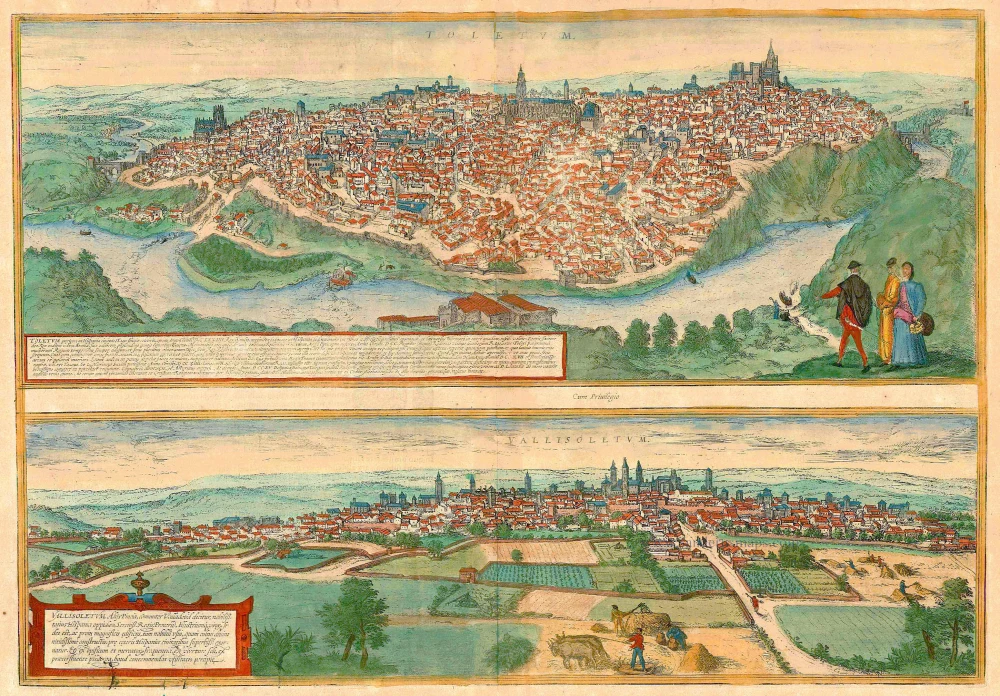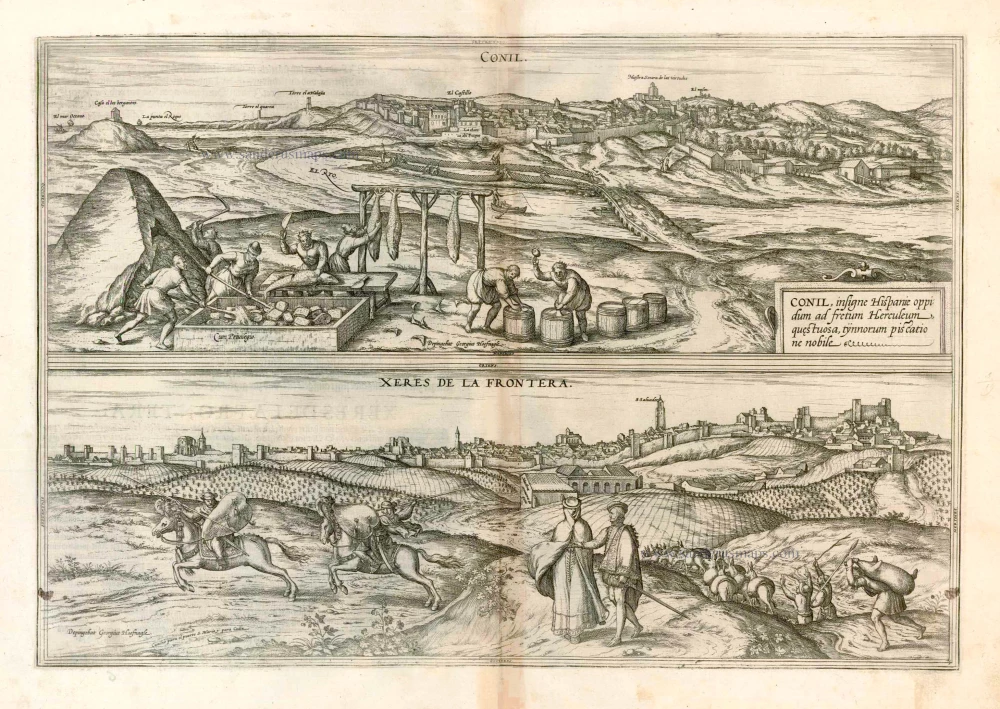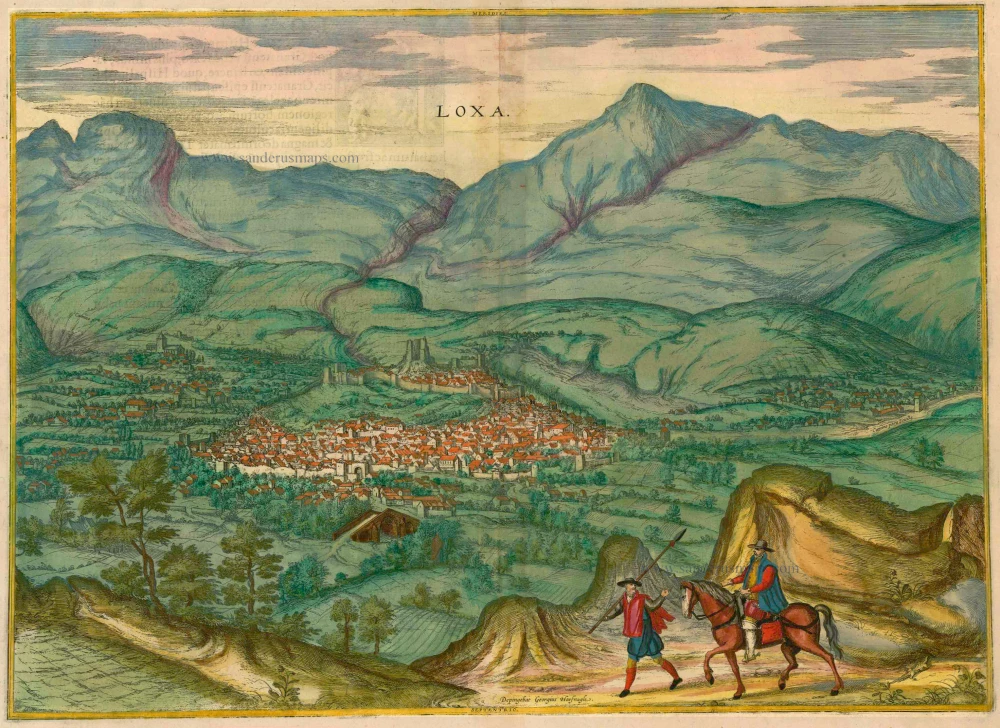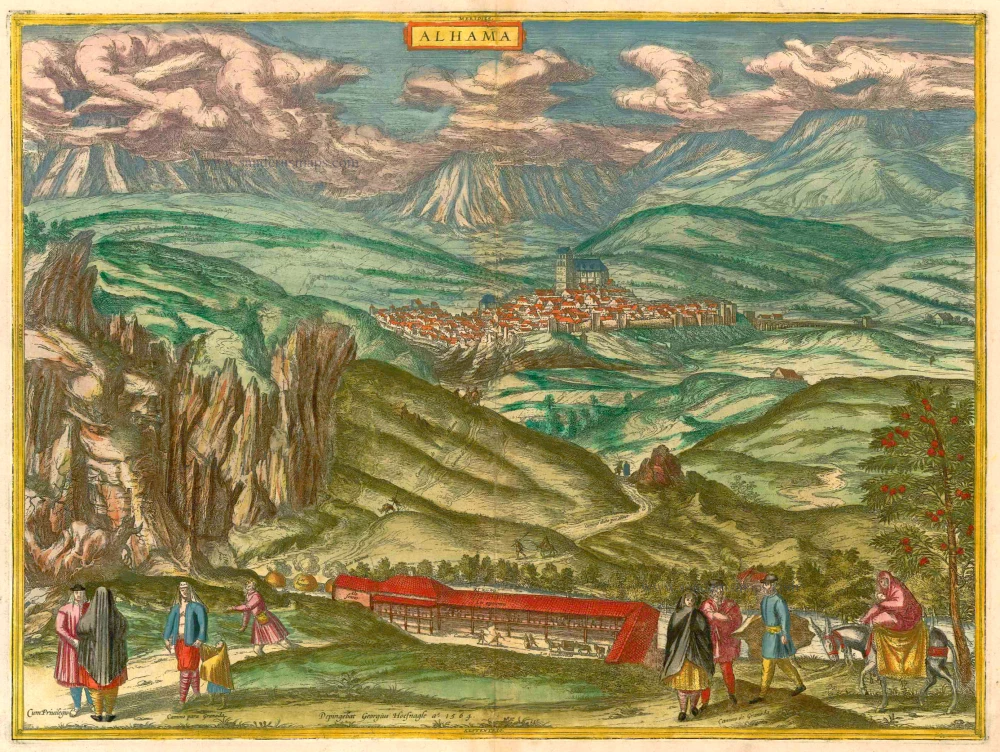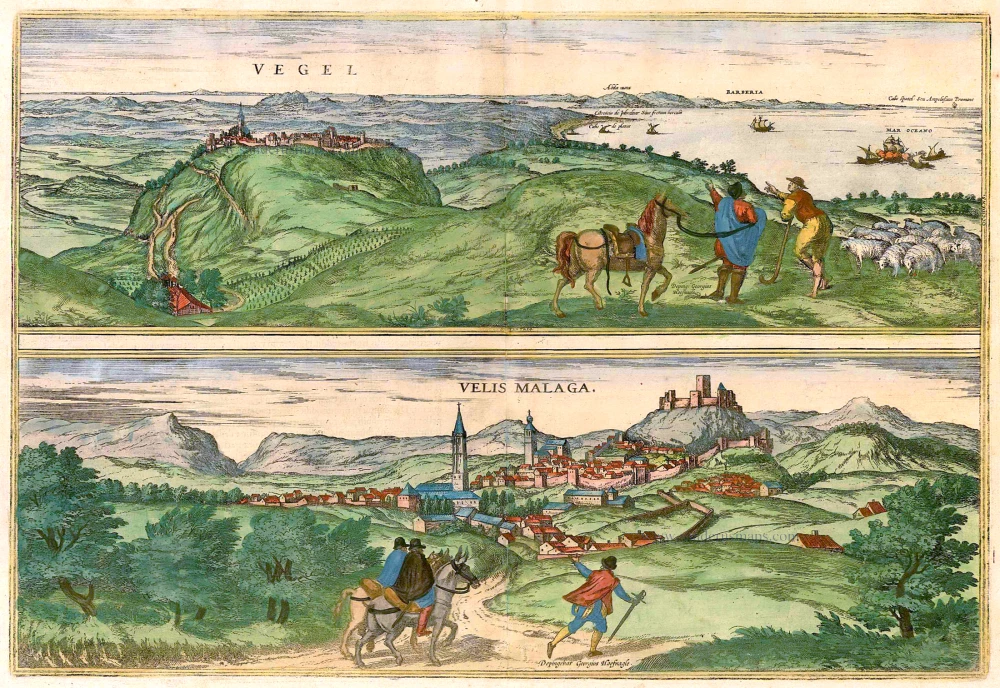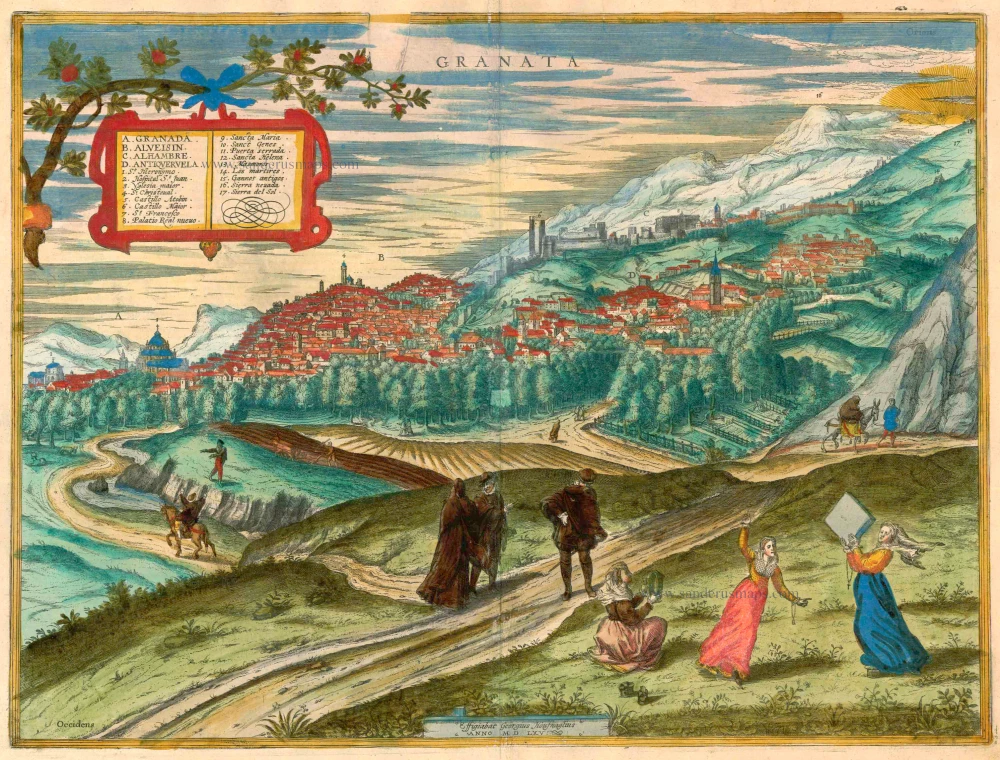Palacios - Alcantarilla - Cabecas by Georg Braun & Frans Hogenberg. 1623
LOS PALACIOS Y VILLAFRANCA
COMMENTARY BY BRAUN: "Los Palacios, a small town in Hispania Baetica, lies beside an ancient castle five miles from Seville, on the road that you take to Cadiz or San Lucar. In summer this road is so dusty that you can hardly find your way, but you need a compass like a seafarer in order not to get lost and suffocate from the great heat."
The view shows Los Palacios, situated south of Seville on the road to Jerez de la Frontera, with its fortress complex from the Moorish era. It was conquered by Ferdinand III of Castile (St Ferdinand) in the mid-13th century. One hundred years later Peter I of Castile, called the Cruel, built an new castle on the ruins of the fortress. In the 18th century Los Palacios merged with the neighbouring commune of Villafranca de la Marisma, hence its present name of Los Palacios y Villafranca. Hoefnagel and Maleparte can be seen riding past in the foreground.
LAS ALCANTARILLAS
COMMENTARY BY BRAUN: "Alcántara, in Spanish Las Alcantarillas, is a place with a bridge over the Palacios marshes. [...] This bridge was built by the Romans, to make it easier to cross the wet and boggy ground, and is famed for its height and wonderfully skilful construction. On one side of the bridge stands a mosque or an old heathen temple belonging to the Moors, which is now consecratie and always closed."
Hoefnagel's travel sketch shows Las Alcantarillas amidst marshland (Marisma) created by the Guadalquivir. The mosque (Mesquita) is visible on the far left, while the centre of the picture is dominated by the Roman stone bridge. Beyond the inn on the right is a glimpse of the large lake then still in existence. The name Las Alcantarillas derives from the Arabic "al-Qantara", meaning "bridge". In the left-hand background lies the goal of Hoefnagel and Maleparte's journey, Las Cabezas.
LAS CABEZAS DE SAN JUAN
On a hill not far from Lebrija, between Seville and Jerez de la Frontera, lies the small town of Las Cabezas de San Juan. The mountain on the left, captioned Sierras de Ronda, in fact lies substantially further away. The ruins mentioned in the text may well represent remains from the Iberian period: Hannibal built a number of defensive towers in Las Cabezas in the 3rd century BC. The artist has immortalized himself at work, seated on a rock in the foreground. (Taschen)
Signed and dated at bottom centre: Painted by Georg Hoefnagel in the year 1565.
Braun G. & Hogenberg F. and the Civitates Orbis Terrarum.
The Civitates Orbis Terrarum, also known as the 'Braun & Hogenberg', is a six-volume town atlas and the most excellent book of town views and plans ever published: 363 engravings, sometimes beautifully coloured. It was one of the best-selling works in the last quarter of the 16th century. Georg Braun, a skilled writer, wrote the text accompanying the plans and views on the verso. Many plates were engraved after the original drawings of a professional artist, Joris Hoefnagel (1542-1600). The first volume was published in Latin in 1572 and the sixth in 1617. Frans Hogenberg, a talented engraver, created the tables for volumes I through IV, and Simon van den Neuwel made those for volumes V and VI. Other contributors were cartographers Daniel Freese and Heinrich Rantzau, who provided valuable geographical information. Works by Jacob van Deventer, Sebastian Münster, and Johannes Stumpf were also used as references. Translations appeared in German and French, making the atlas accessible to a broader audience.
Since its original publication of volume 1 in 1572, the Civitates Orbis Terrarum has left an indelible mark on the history of cartography. Seven more editions followed the first volume in 1575, 1577, 1582, 1588, 1593, 1599, and 1612. Vol.2, initially released in 1575, saw subsequent editions in 1597 and 1612. The subsequent volumes, each a treasure trove of historical insights, graced the world in 1581, 1588, 1593, 1599, and 1606. The German translation of the first volume, a testament to its widespread appeal, debuted in 1574, followed by the French edition in 1575.
Several printers were involved: Theodor Graminaeus, Heinrich von Aich, Gottfried von Kempen, Johannis Sinniger, Bertram Buchholtz, and Peter von Brachel, all of whom worked in Cologne.
Georg Braun (1541-1622)
Georg Braun, the author of the text accompanying the plans and views in the Civitates Orbis Terrarum, was born in Cologne in 1541. After his studies in Cologne, he entered the Jesuit Order as a novice, indicating his commitment to learning and intellectual pursuits. In 1561, he obtained his bachelor's degree; in 1562, he received his Magister Artium, further demonstrating his academic achievements. Although he left the Jesuit Order, he continued his studies in theology, gaining a licentiate in theology. His theological background likely influenced the content and tone of the text in the Civitates Orbis Terrarum, adding a unique perspective to the work.
Frans Hogenberg (1535-1590)
Frans Hogenberg was a Flemish and German painter, engraver, and mapmaker. He was born in Mechelen as the son of Nicolaas Hogenberg.
By the end of the 1560s, Frans Hogenberg was employed upon Abraham Ortelius's Theatrum Orbis Terrarum, published in 1570; he is named an engraver of numerous maps. In 1568, he was banned from Antwerp by the Duke of Alva and travelled to London, where he stayed a few years before emigrating to Cologne. He immediately embarked on his two most important works, the Civitates, published in 1572 and the Geschichtsblätter, which appeared in several series from 1569 until about 1587.
Thanks to large-scale projects like the Geschichtsblätter and the Civitates, Hogenberg's social circumstances improved with each passing year. He died as a wealthy man in Cologne in 1590.
Palacios [on sheet with:] Alcanerilla [and] Cabecas.
Item Number: 103 Authenticity Guarantee
Category: Antique maps > Europe > Spain and Portugal
Antique map with three views by Braun and Hogenberg: Los Palacios y Villafranca - Las Alcantarillas - Las Cabezas de San Juan.
Engraved after drawings by Georg Hoefnagel.
Date of the first edition: 1596
Date of this map: 1623
Copper engraving
Size: 36.5 x 49cm (14.2 x 19.1 inches)
Verso text: Latin
Condition: Old coloured, excellent.
Condition Rating: A
References: Van der Krogt 4, 2468; Taschen, Braun and Hogenberg, p.356.
From: Urbium Praeipuarum Mundi Theatrum Quintum Auctore Georgio Braunio Agrippinate. Part 5. Köln, Petrus von Brachel, 1623. (Van der Krogt 4, 41:1.5)
LOS PALACIOS Y VILLAFRANCA
COMMENTARY BY BRAUN: "Los Palacios, a small town in Hispania Baetica, lies beside an ancient castle five miles from Seville, on the road that you take to Cadiz or San Lucar. In summer this road is so dusty that you can hardly find your way, but you need a compass like a seafarer in order not to get lost and suffocate from the great heat."
The view shows Los Palacios, situated south of Seville on the road to Jerez de la Frontera, with its fortress complex from the Moorish era. It was conquered by Ferdinand III of Castile (St Ferdinand) in the mid-13th century. One hundred years later Peter I of Castile, called the Cruel, built an new castle on the ruins of the fortress. In the 18th century Los Palacios merged with the neighbouring commune of Villafranca de la Marisma, hence its present name of Los Palacios y Villafranca. Hoefnagel and Maleparte can be seen riding past in the foreground.
LAS ALCANTARILLAS
COMMENTARY BY BRAUN: "Alcántara, in Spanish Las Alcantarillas, is a place with a bridge over the Palacios marshes. [...] This bridge was built by the Romans, to make it easier to cross the wet and boggy ground, and is famed for its height and wonderfully skilful construction. On one side of the bridge stands a mosque or an old heathen temple belonging to the Moors, which is now consecratie and always closed."
Hoefnagel's travel sketch shows Las Alcantarillas amidst marshland (Marisma) created by the Guadalquivir. The mosque (Mesquita) is visible on the far left, while the centre of the picture is dominated by the Roman stone bridge. Beyond the inn on the right is a glimpse of the large lake then still in existence. The name Las Alcantarillas derives from the Arabic "al-Qantara", meaning "bridge". In the left-hand background lies the goal of Hoefnagel and Maleparte's journey, Las Cabezas.
LAS CABEZAS DE SAN JUAN
On a hill not far from Lebrija, between Seville and Jerez de la Frontera, lies the small town of Las Cabezas de San Juan. The mountain on the left, captioned Sierras de Ronda, in fact lies substantially further away. The ruins mentioned in the text may well represent remains from the Iberian period: Hannibal built a number of defensive towers in Las Cabezas in the 3rd century BC. The artist has immortalized himself at work, seated on a rock in the foreground. (Taschen)
Signed and dated at bottom centre: Painted by Georg Hoefnagel in the year 1565.
Braun G. & Hogenberg F. and the Civitates Orbis Terrarum.
The Civitates Orbis Terrarum, also known as the 'Braun & Hogenberg', is a six-volume town atlas and the most excellent book of town views and plans ever published: 363 engravings, sometimes beautifully coloured. It was one of the best-selling works in the last quarter of the 16th century. Georg Braun, a skilled writer, wrote the text accompanying the plans and views on the verso. Many plates were engraved after the original drawings of a professional artist, Joris Hoefnagel (1542-1600). The first volume was published in Latin in 1572 and the sixth in 1617. Frans Hogenberg, a talented engraver, created the tables for volumes I through IV, and Simon van den Neuwel made those for volumes V and VI. Other contributors were cartographers Daniel Freese and Heinrich Rantzau, who provided valuable geographical information. Works by Jacob van Deventer, Sebastian Münster, and Johannes Stumpf were also used as references. Translations appeared in German and French, making the atlas accessible to a broader audience.
Since its original publication of volume 1 in 1572, the Civitates Orbis Terrarum has left an indelible mark on the history of cartography. Seven more editions followed the first volume in 1575, 1577, 1582, 1588, 1593, 1599, and 1612. Vol.2, initially released in 1575, saw subsequent editions in 1597 and 1612. The subsequent volumes, each a treasure trove of historical insights, graced the world in 1581, 1588, 1593, 1599, and 1606. The German translation of the first volume, a testament to its widespread appeal, debuted in 1574, followed by the French edition in 1575.
Several printers were involved: Theodor Graminaeus, Heinrich von Aich, Gottfried von Kempen, Johannis Sinniger, Bertram Buchholtz, and Peter von Brachel, all of whom worked in Cologne.
Georg Braun (1541-1622)
Georg Braun, the author of the text accompanying the plans and views in the Civitates Orbis Terrarum, was born in Cologne in 1541. After his studies in Cologne, he entered the Jesuit Order as a novice, indicating his commitment to learning and intellectual pursuits. In 1561, he obtained his bachelor's degree; in 1562, he received his Magister Artium, further demonstrating his academic achievements. Although he left the Jesuit Order, he continued his studies in theology, gaining a licentiate in theology. His theological background likely influenced the content and tone of the text in the Civitates Orbis Terrarum, adding a unique perspective to the work.
Frans Hogenberg (1535-1590)
Frans Hogenberg was a Flemish and German painter, engraver, and mapmaker. He was born in Mechelen as the son of Nicolaas Hogenberg.
By the end of the 1560s, Frans Hogenberg was employed upon Abraham Ortelius's Theatrum Orbis Terrarum, published in 1570; he is named an engraver of numerous maps. In 1568, he was banned from Antwerp by the Duke of Alva and travelled to London, where he stayed a few years before emigrating to Cologne. He immediately embarked on his two most important works, the Civitates, published in 1572 and the Geschichtsblätter, which appeared in several series from 1569 until about 1587.
Thanks to large-scale projects like the Geschichtsblätter and the Civitates, Hogenberg's social circumstances improved with each passing year. He died as a wealthy man in Cologne in 1590.

